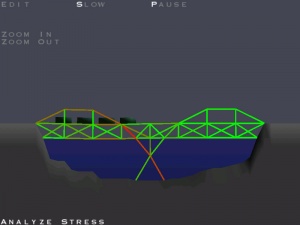Difference between revisions of "CS382:Structural-outline"
(→Background reading) |
(→Lecture notes) |
||
| Line 37: | Line 37: | ||
'''Lecture 3:''' | '''Lecture 3:''' | ||
| + | -Review Lab 1 | ||
| + | -Since we are aiming to fill two weeks with this unit, this lecture could introduce a new 'variable' that might not have been introduce in the previous week. Maybe expanding into three dimensions. Another option would be to move away from bridges at this point and look at something like video game physics engines. | ||
| + | -Prepare students to complete lab 2. | ||
'''Lecture 4:''' | '''Lecture 4:''' | ||
| + | |||
| + | -Finish the sub-unit on physics engines, and relate it back to the bridge builder program and the notion of rigid body dynamics. | ||
| + | -Relate the Bridge/structural modeling unit to the previous units, try to reassure everyone and allieviate any confusions or further questions that students might have. | ||
=Classroom response questions= | =Classroom response questions= | ||
Revision as of 19:16, 16 February 2009
Background reading
Note: Provide pointer to reading and some notes about it.
http://pghbridges.com/basics.htm This is a page containing a number of basic types of bridges, and some information about their origin, and/or how they function.
http://www.in.gov/indot/files/bridge_chapter_01.pdf - "Bridge building for dummies." Provides an explanation of the duties of Bridge Technicians and defines a number of terms associated with bridge constructions, as well as explaining some of the more common failure points and why they're failure points.
http://en.wikipedia.org/wiki/Rigid_body_dynamics
http://www.lessonplanspage.com/ScienceSSOKNEXBridges-Architecture510.htm - The lesson plan that involves K'nex, if we want to go ahead with that.
http://www.apeg.bc.ca/services/branches/documents/pr/Bridge_Engineering_Principles.pdf - Goes over some of the basic principles of bridge-building.
http://www.yale.edu/ynhti/curriculum/units/2001/5/01.05.04.x.html - Lesson plan for younger students. Could be useful for building a lecture for an audience with little to no background.
Lecture notes
Note: Write in Outline Form
Note: The idea behind this unit is a 2-week unit exploring how it is possible to model structures such as bridges using 3D Modeling tools. We will try to teach the students how the physical properties of structures in the real world can be represented inside computational systems. Because our current software is biased towards the modeling and simulation of Bridges, this is what the unit will be based on modeling. However, we are interested in maybe expanding the scope of this unit into a basic overview of rigid body dynamics.
Lecture 1:
-Review key concepts from the units on static and dynamic models, remind people of the difference, and how the two types of models work in conjunction.
-Explain the various types of bridges introduced in Bridge Basics
-Prepare the class to do the lab. If they're going to use bridge builder, this section could be a demonstration of the software and features.
Lecture 2:
-Begin to explain the more complex aspects and issues surrounding rigid body dynamics.
-RBD involves solid objects and their interaction with other objects in a simulated world.
Lecture 3:
-Review Lab 1 -Since we are aiming to fill two weeks with this unit, this lecture could introduce a new 'variable' that might not have been introduce in the previous week. Maybe expanding into three dimensions. Another option would be to move away from bridges at this point and look at something like video game physics engines. -Prepare students to complete lab 2.
Lecture 4:
-Finish the sub-unit on physics engines, and relate it back to the bridge builder program and the notion of rigid body dynamics. -Relate the Bridge/structural modeling unit to the previous units, try to reassure everyone and allieviate any confusions or further questions that students might have.
Classroom response questions
Note: Include at least 3
Lab activity
Note: Include Process, Software, and Materials.
Simulations
1. Bridge Builder
Simple, effective, fun bridge building/simulation game. Illustrates structural stress with colors. Might be too simplistic, because it only simulates in 2 Dimensions. Additionally, the software appears to be non-free, and although there is a free 'demo' download for mac/windows. The demo appears fully functional, however the Bridge Builder website advertises a 3-D version with a paid licence.
The program is organized into 'Levels' ranging in difficulty from 'Level 1' and 'Level 15.' This could translate to a convient lab format, where we can assign a certain number of levels. There are some good videos on youTube that demonstrate the increased challenge of each subsequent level. youTube:Level 6 - 14 in Bridge Builder
An open source physics engine used in many applications. This came from a search on physics engines, which seem to be heavily related to modeling bridges and other structures. There might be some pedagogically useful aspects of this software, however delving to deep into the intracacies of linear algebra and vector multiplication might seriously confuse and frustrate many of the non-math people. Note that it may be possible to implement some pre-built objects / functions to make the software more accessible to newbies.
Physical Models
1. K'nex would make an effective physical analogue to the computer simulation methods described above. It might make sense to instruct the students to build 2-dimensional K'nex models, in an effort to both simplify the process, and make the physical model the same as the bridge builder model. The strength of these K'nex constructions could be tested simply by hanging weights off of them at various points.
